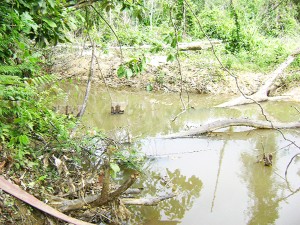Following investigations, the Guyana Geology and Mines Commission (GGMC) issued cease-work orders to miners who were polluting the Arau River.

The regulatory body head, William Woolford said that some villagers were also involved in mining and were polluting the water too. In a letter to Stabroek News recently, the GGMC Com-missioner said that following the publication of a report in this newspaper about the continuing mining pollution in the River at the remote Region Seven community, a team was dispatched to the area and spent three weeks there. The team consisted of the Mines Manager and two other officers.
In the letter, Woolford said that the team inspected mining operations at Arau bottom, below Arau Village where the majority of the operations were located and operations at Arau top located above Arau Village. He stated that there were twelve dredges, seven at Arau bottom and five at Arau top and five out of the seven dredges at Arau bottom were operating within the village’s titled area with verbal permission of the village, and they were all unregistered and unlicensed. Three of these were acknowledged as being owned by villagers, including the Toshao, he wrote in his letter.
“One of the dredges operating in the titled area and acknowledged as being owned by a villager was responsible for the most severe turbid discharge, measured as 800 NTU (turbidity units), discharging directly into Arau River (at Arau bottom below the village)”, he said. Water with a NTU of 30, which would be barely cloudy to the eye is the standard required for discharge into waterways under the mining regulations.
On a visit to the community in March, following an earlier visit last year, this newspaper had reported that environmentally unsound mining practices continued despite many complaints to several government agencies and residents of the indigenous community had pleaded for proper regulation of such activities. Stabroek News had visited Arau Top, where breaches of the mining regulations by the operations, were observed.
Woolford said that the team’s report revealed that five dredges were found at Arau Top. He stated that they were all registered and licensed and were located in state land well above Arau Village, and outside of Arau titled area and the surrounding 1-km wide buffer area. At Arau Top, discharges from the two working dredge operations into Arau River measured 250 and 241 NTU respectively, he said. The Commissioner pointed out that one of the seven dredges at Arau bottom and three of the five dredges at Arau top were working at the time of the inspection. Cease Work Orders were issued on all four of these operations, two for discharging turbid water directly into Arau River and two for diverting Arau River without permission, he said in the letter pointing out that those are offences under the Mining Act and Regulations. Particularly, he noted, it is an offence to discharge tailings with turbidity greater than 50 NTU into the environment. In addition, citations (official warnings) were issued on the two dredges at Arau bottom outside of Arau titled area, which although they were not working at the time of the inspection, were positioned to discharge tailings directly into Arau River, he said.
Dilution
The Commissioner stated that water samples were tested for turbidity at several places in Arau top and bottom, including in Warishi Creek which is used by Arau villagers for domestic purposes, around the confluence of the Arau River and Wenamu River, and Eteringbang on the Cuyuni River. Following standard procedure, water samples were taken above and below mining operations to assess the turbidity impact of mining and its dilution downstream, he stated.
Woolford said that turbidity values recorded from upstream to downstream were: 136 NTU above and 241 NTU below the three working operations at Arau top. The undisturbed ‘black’ water of Warishi Creek recorded a reading of 7 NTU.
The Arau River below Arau Village and above dredging operations at Arau bottom gave a reading of 80 NTU while a reading of 800 NTU was given, where a villager’s dredge was discharging into the Arau River. Additionally, water turbidity values of 281 NTU was recorded at the Arau River confluence with the Wenamu River; 21 NTU in the Wenamu River below the Arau River confluence at Mango Landing; 10 NTU at Muruwawe River below Arau River; 41 NTU above the Wenamu confluence with Cuyuni River; 24 NTU at the Wenamu confluence; and 37 NTU at Eteringbang below Wenamu confluence on the Cuyuni River.
Travelling
According to Woolford, the team met with the Arau Village Toshao, three councillors, several residents of Arau Village and miners on March 27. The toshao and villagers reported that the expense of travelling to Georgetown was a deterrent to regularizing their mining operations, he said.
The GGMC commissioner stated that “in addition to acknowledging that miners were given verbal permission by Arau Village to mine within the titled area, it was disclosed that while Arau villagers themselves plan to further invest in mining and to mine in accordance with the Mining Act and Regulations, they did not want GGMC to issue permits and claims for mining in the vacant state land around Arau titled area nor around Arau Village”. The commissioner had noted that Arau Village is presently situated outside and south southwest of the Arau titled area on the outer boundary of the 1-km wide buffer area. He said that mining is prohibited by law in the buffer area.
Villagers are currently trying to get their titled land extended to cover the village.
Woolford noted that the GGMC is currently a respondent in an application by Arau Village v Attorney General’s Chambers and GGMC, and in D’Abreo v GGMC.
He said that the GGMC team advised the villagers that permission to mine within the Arau titled area must be given in writing by the Village Council, and that the Mining Regulations require that permission to mine must be sought and obtained from GGMC before mining commences. “The GGMC team stressed that all mining operations, within and outside Amerindian titled areas are required to comply with the Mining Act and Regulations, and they assured the villagers that consistent with its traditional and extant policy and practice for mining in Amerindian titled areas (formerly ‘reservations’) based on the law, GGMC has never hitherto issued lands for mining within the Arau titled area, nor within its 1-km wide buffer area. In fact, (except for those operations in the Arau titled area) the current operations are located in mining claims outside of the Arau titled area and its surrounding buffer zone, and further, most of the lands were issued before the Arau area became titled”, he stated.
The commissioner said that another area of concern voiced by the villagers was the operation of illegal business premises (about 10 to 15 shops) at Mango Landing below Arau Village, with associated alcohol consumption and transmission of STDs (through prostitution).
He declared that the GGMC team committed to deploying officers from the Cuyuni Mining Station to deal with general matters at Mango Landing and to train an Arau resident selected by the villagers to be a Community Mines Ranger employed by the GGMC. In addition to enforcing the law, GGMC is committed to working with all small and medium scale miners to improve their tailings management practices in order to be compliant with the law with respect to tailings discharge and environmental management in general, he declared.





